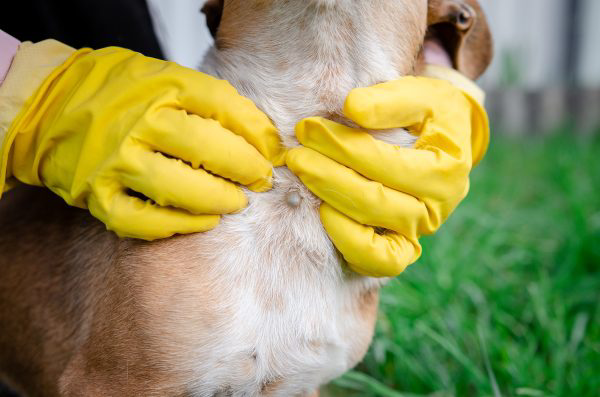
Mosquito Joe provides insights on tick prevention for your pet.
|
Fleas and ticks on dogs are a common concern for all pet owners. These parasites are attracted to warm-blooded hosts like dogs and cats that allow them to feed and breed. Unfortunately, ticks pose a series of health risks to both dogs and their owners. By learning about tick behavior, you can help stop their breeding cycle, and Mosquito Joe® can help. From providing pest control tips to offering professional treatments, we’re dedicated to helping ensure the comfort and well-being of your family.
How Do Ticks Breed?
Ticks can breed quickly and are sometimes hard to spot, making tick infestations such a common problem. It can start with your dog when they venture outside or during a walk in a grassy or wooded area. Though the breeding process can vary by tick species, these general steps can take from weeks to months, depending on conditions in your area:
- Female ticks begin feeding on their host, such as a dog.
- Male ticks also feed for their sperm to develop, though they don’t become as engorged as the females.
- A male tick on a dog will wait for a female to attach near them on the same host.
- Males will detach from the host and attach to the female to mate.
- Male ticks will mate with the females as they continue to feed and become engorged.
- Once the females are done, they will detach from the host and drop to the ground, where they will lay their eggs.
- Tick eggs take around five to 20 days to mature before hatching and initiating their lifecycle.
If you can detect ticks on dogs early, you can prevent them from breeding and creating a larger tick problem. Remove ticks as soon as you find them, and contact your veterinarian for any health concerns.
How Do Dogs Get Ticks?
Dogs are most likely to get ticks from their time outside. Ticks participate in “questing,” which is a process where they wait and look for their next host. They can crawl up to 24 inches through tick tall grasses and plants to help connect with their host. When dogs roll on the ground or brush up against the plants, the ticks will use their front legs to grab the host, crawl through their fur, and attach to their skin. Ticks cannot fly or jump, so they rely on climbing and crawling to get their next blood meal.
If you can eliminate these things from your yard, you can reduce the chance that you’ll have a tick problem:
- Tall grass and overgrown plants: These can harbor ticks and give them easy access to your dog and the rest of your family.
- Leaf piles: Since these areas are also prime spots for ticks to hide and breed, keeping them clear can reduce the number of spots ticks like to gather.
- Animal and bird feeders: Ticks are often found in areas because they can attach themselves to the rodents who eventually come to eat the birdseed or other feed. They wait for an animal to come by and attach to them while they feed.
Dogs can also get ticks by coming into contact with other animals carrying them, like at dog parks or during walks. Spending time in places with tick-infested animals increases the chance of dogs picking up ticks from the environment. Be extra aware of tick risks in wooded and grassy areas, especially during warmer months. Also, be sure to check yourself and your clothing since you can bring ticks into your home where they fall off of you and attach to your pet.
What Do Ticks Do to Dogs?
Ticks are parasitic arachnids that carry harmful bacteria, viruses, and parasites. A tick bite could put your furry friend at risk of:
- Lyme disease
- Babesiosis
- Anaplasmosis
- Ehrlichiosis
- Anemia
- Kidney failure
- Irritation
- Allergic reactions
- Paralysis
- Death
Knowing what to do if your dog has a tick will help mitigate these issues. In addition to using preventatives, be sure to check your dog for ticks after outdoor activities. If you’re wondering, “What does a tick look like on a dog?” you can usually keep an eye out for a brown or black bump around the size of a mole or large wart. If you find a tick on a dog, remove it immediately and carefully using tweezers or a tick removal tool to reduce the risk of infection. You should also monitor for any potential symptoms of a tick-borne illness, such as loss of appetite, lethargy, lameness, and fever.
Do Ticks Lay Eggs on Dogs?
Ticks don’t lay eggs on dogs. Host animals are not involved in the egg-laying process but rather provide the blood essential for ticks to feed on prior to breeding. After mating, female ticks on dogs detach and search for moist, sheltered spots in the environment to lay their eggs, such as grass, leaf litter, or wooded areas. Depending on the tick species, a single female tick can lay 1,000 to 18,000 eggs once she has detached. After laying the eggs, the female tick will die.
Once the eggs hatch, the larvae, also known as seed ticks, will seek out hosts such as dogs for their first blood meal. By laying eggs in the environment, ticks increase the spread and survival odds as they move across different habitats and find new hosts with ease.
Tips for Tick Prevention
As ticks continue to extend their habitat across the U.S., the potential for tick and mosquito-borne diseases has also grown. When it comes to fleas and ticks on dogs, regular prevention can help prevent their bites and associated health risks. Consider regular tick prevention medications recommended by your vet. It's important to follow your vet's advice on the best treatment options for your dog, whether it's topical treatments, oral medications, or tick collars.
Veterinarian-recommended collars help, but outdoor tick protection for your yard adds another layer of defense. Our services treat your yard and create a better environment for both you and your pets. Contact us today for a free estimate. For additional assurance, know that our services are backed by our own Mosquito Joe Satisfaction Guarantee and the Neighborly Done Right Promise®.
This article is intended for general informational purposes only and may not be applicable to every situation. You are responsible for determining the proper course of action for your home and property. Mosquito Joe is not responsible for any damages that occur as a result of this blog content or your actions. For the most accurate guidance, contact your local Mosquito Joe location for a comprehensive, on-site assessment.
